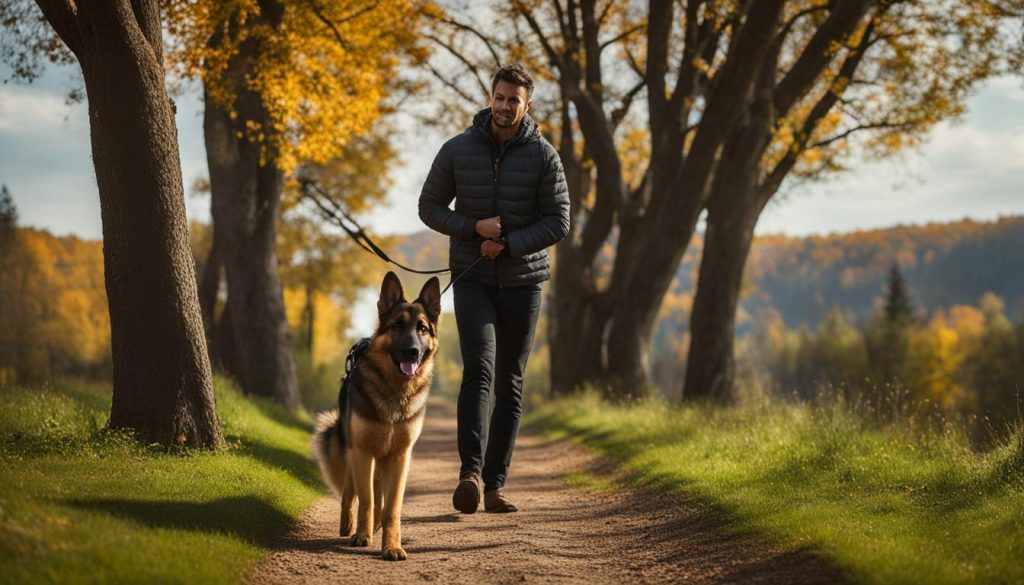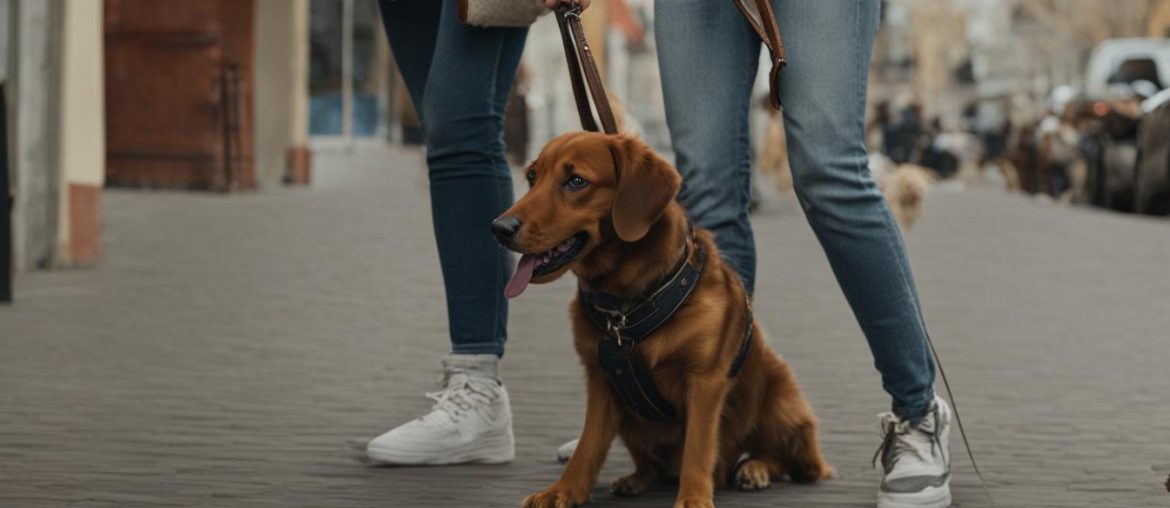Teaching your dog to walk next to you without pulling on the leash is a valuable skill that promotes responsible dog ownership and makes walks more enjoyable. In this guide, I will provide step-by-step instructions on how to teach your dog to heel and walk beside you.
Key Takeaways
- Heel training promotes safe-walking practices and strengthens the bond between you and your dog.
- Necessary tools for heel training include a collar or harness, a quality leash, high-value treats, a clicker, and verbal rewards.
- Step-by-step guide to heel training involves positioning your dog on your left side, using treats as rewards, and gradually increasing the difficulty of the training.
- Remain calm and patient, avoid pulling your dog with the leash, and provide consistent commands and praise during training.
- Regular practice is essential for successful heel training, and seeking professional assistance is an option for those who need extra help.
Why is Heel Training Important?
Heel training is an essential aspect of dog walking etiquette. It promotes safe and enjoyable walks for both you and your furry companion. By teaching your dog to walk calmly beside you without pulling on the leash, you can prevent them from getting into mischief or harm’s way. Heel training also strengthens the bond between you and your dog, fostering trust and effective communication.
Furthermore, heel training establishes you as the leader in your dog’s eyes. It helps them understand their place in the family unit and reinforces the idea that you are the one in control. By mastering this skill, your dog will develop good leash manners, displaying a more obedient and controlled behavior while on walks.
Walking with a dog who knows how to heel also enhances walking etiquette for dogs. It ensures that your dog remains close to you, allowing others to pass by easily without any disruptions. This courteous behavior is valued by other dog owners and pedestrians, making your walks more enjoyable for everyone involved.

In summary, heel training is important for various reasons. It encourages safe and controlled walking practices, strengthens the bond between you and your dog, establishes you as the leader, teaches good leash manners, and improves walking etiquette for dogs. By investing time and effort into heel training, you can create a harmonious walking experience and foster responsible dog ownership.
Necessary Tools for Heel Training
To teach your dog to heel effectively, you will need a few essential tools. These tools will help you create a structured and positive training experience for your furry friend. Here are the necessary tools for successful heel training:
- A comfortable collar or harness: Choose a collar or harness that fits your dog well and does not cause any discomfort. This will ensure that your dog is at ease during the training sessions.
- A sturdy leash: Invest in a high-quality leash that is strong enough to provide control without causing harm to your dog. A reliable leash will make it easier for you to guide your dog and maintain their position beside you.
- High-value treats: Use small, tasty treats that your dog loves as rewards for good behavior. These treats will motivate your dog to stay focused and learn the heel command effectively.
- A clicker: A clicker is a useful training tool that helps reinforce positive behavior. By associating the sound of the clicker with rewards, your dog will understand when they have done something correctly.
- Verbal rewards: In addition to treats and using a clicker, verbal praise is crucial for reinforcing good behavior. Use positive and enthusiastic vocal cues to let your dog know they are doing a great job.
Having these tools readily available will ensure that you are well-prepared for heel training sessions with your dog. To put it simply, consistency and positive reinforcement are key when teaching your dog to walk beside you without pulling on the leash.

| Tool | Description |
|---|---|
| Collar or Harness | A comfortable collar or harness that fits your dog well without causing discomfort. |
| Leash | A sturdy leash that provides control without causing harm to your dog. |
| High-Value Treats | Small, tasty treats that your dog loves, used as rewards for good behavior. |
| Clicker | A training tool that makes a distinct sound to reinforce positive behavior. |
| Verbal Rewards | Positive and enthusiastic verbal praise to reinforce good behavior. |
Step-by-Step Guide to Heel Training
Heel training is an essential skill for any dog owner who wants to enjoy peaceful and controlled walks. With patience and consistency, you can teach your dog to walk beside you without pulling on the leash. Follow this step-by-step guide to start heel training:
Step 1: Start in an enclosed area
Begin the training process in a quiet and enclosed area, such as your backyard or a secure park. This will minimize distractions and allow your dog to focus on learning. Attach the leash to your dog’s collar or harness and use a verbal cue, such as “heel” or “walk,” along with a hand motion to signal your dog to stay by your side.
Step 2: Position and reward
Position your dog on your left side and hold a high-value treat in your right hand at nose level. Take a step forward and click, then reward your dog with the treat when they take a step in the right direction. Repeat this process, clicking and rewarding each time your dog moves closer to a proper heel position.
Step 3: Correct and redirect
If your dog starts to wander off or pull on the leash, stop walking and calmly command them to sit. Once they are sitting, reward them with a treat when they comply. Gradually increase the time your dog must stay by your side before receiving a reward. This will reinforce the desired behavior and help your dog understand that staying beside you is rewarding.
| Do | Don’t |
|---|---|
| Use high-value treats as rewards | Yell or punish your dog |
| Be consistent with your commands | Pull your dog with the leash |
| Keep training sessions short and frequent | Give up if progress is slow |
| Provide verbal praise and encouragement | Use excessive force or harsh corrections |
Step 4: Introduce the heel command
Once your dog is comfortable walking beside you, introduce the verbal cue “heel” while using a treat as a lure. Hold the treat in your hand and guide your dog into the correct position. Reward them every few steps with a click and a treat, as well as verbal praise. Gradually reduce the reliance on treats and increase the focus on verbal praise to reinforce the behavior.
Try to practice in different environments with increasing distractions to solidify the heel command. With consistent training, your dog will become proficient in loose leash walking and enjoy pleasant walks by your side.
Tips for Successful Heel Training
Successfully teaching your dog to walk next to you without pulling on the leash requires patience, consistency, and positive reinforcement. Here are some tips to help you achieve success in your heel training:
- Remain calm and patient throughout the training process. Dogs respond best to positive reinforcement and will learn more effectively in a calm environment.
- Take breaks during training sessions to prevent your dog from getting overwhelmed or burned out. Short, frequent training sessions are often more effective than long, intensive ones.
- Avoid pulling your dog with the leash. Instead, use gentle guidance to keep them in the right position. Pulling can create tension and discomfort for your dog, making it more difficult for them to learn.
- Be consistent with your commands and use the same phrase or word each time. This will help your dog associate the command with the desired behavior.
- Keep training sessions short but consistent. Gradually increase the length and difficulty of the sessions as your dog progresses. Regular practice is key to reinforcing the heel command.
- Provide plenty of praise and love to motivate your dog during training. Positive reinforcement will help them associate heeling with a positive experience.

Heel training can be challenging at times, but with consistent effort and the right techniques, you can teach your dog to walk beside you like a pro. Try to be patient, stay positive, and seek professional assistance if needed. With practice, your dog will become a well-behaved walking companion and enjoy pleasant walks together.
Practice Makes Perfect
Regular practice is essential for successful heel training. Treat every walk as a training session and reinforce the heel command consistently. With patience, consistency, and plenty of positive reinforcement, your dog will learn to walk next to you like a pro.
Here are some tips to keep in mind during your practice sessions:
- Start in a low-distraction environment and gradually increase the difficulty by adding distractions such as other dogs or people.
- Use a clicker or verbal cue to signal your dog to heel.
- Hold a treat at nose level to guide your dog into the correct position and reward them when they stay by your side.
- Be consistent with your commands and use the same phrase or word each time.
- Keep training sessions short but frequent to maintain your dog’s focus.
- Provide plenty of praise and love to motivate your dog and make the training enjoyable.
To put it simply, practice makes perfect! It may take time for your dog to fully grasp the concept of heel training, so be patient and celebrate every small success. The more you practice together, the stronger your bond will become, and the better your dog will become at walking calmly beside you.

| Common Challenges | Solutions |
|---|---|
| Distracted or wandering off | Stop walking and call your dog’s name to regain their attention and lure them back to your side with a treat. |
| Struggling to stay by your side | Go back to practicing in a low-distraction environment and gradually reintroduce distractions. |
| Pulling on the leash | Stop walking and wait for your dog to relax before continuing. Consider using a body harness or head collar for additional control. |
Incorporating these tips into your practice sessions will help you overcome common challenges and ensure that your dog becomes a pro at walking next to you.
Troubleshooting Common Challenges
While teaching your dog to walk next to you can be a rewarding experience, it is not without its challenges. Here are some common issues that dog owners may encounter during heel training and how to overcome them:
Distracted Behavior
It’s not uncommon for dogs to become easily distracted during walks, especially in new environments or when encountering other dogs or people. If your dog becomes distracted or wanders off, stop walking and call their name until they return to you. Use treats and verbal praise to reward them for coming back to your side, reinforcing the desired behavior. You may need to practice in a low-distraction environment before gradually reintroducing distractions.
Difficulty Staying by Your Side
If your dog struggles to stay by your side and consistently wanders off, reinforce the heel command in a controlled setting. Start by practicing in a familiar, enclosed area with minimal distractions. Gradually increase the difficulty by introducing new environments with more distractions. Be patient and consistently reward your dog for staying by your side, gradually increasing the duration before giving a reward.
Pulling on the Leash
Pulling on the leash is a common issue during walks, but it can be corrected with proper training techniques. When your dog pulls on the leash, stop walking and wait for them to relax before continuing. Consider using a body harness or head collar for additional control and to discourage pulling behavior. Try to reward your dog for walking calmly beside you and to provide clear guidance through gentle leash cues.

| Challenge | Solution |
|---|---|
| Distracted Behavior | Stop walking and call your dog’s name, reward them for coming back to your side. |
| Difficulty Staying by Your Side | Practice in a low-distraction environment, gradually increase difficulty, and reward your dog for staying by your side. |
| Pulling on the Leash | Stop walking, wait for your dog to relax, consider using a body harness or head collar, reward calm behavior. |
By addressing these common challenges with patience, consistency, and positive reinforcement, you can overcome them and successfully teach your dog to walk next to you without pulling on the leash. Try to remain calm and patient throughout the training process, and seek professional assistance if needed.
Professional Assistance
Teaching your dog to walk next to you without pulling on the leash can be a challenging task. If you’re struggling with training or don’t have the time to dedicate to it, seeking professional assistance can be a great option. Dog training consultants have the expertise and experience to guide you through the process and help you achieve your dog training goals.
Professional trainers can provide personalized training plans tailored to your dog’s specific needs and temperament. They can identify any behavioral issues and develop effective strategies to address them. With their guidance, you can learn the most effective techniques and methods to teach your dog to heel and walk politely by your side.
Additionally, professional trainers can offer support and guidance throughout the training process. They can answer your questions, provide feedback on your progress, and make adjustments to the training plan as needed. Their expertise can save you time and frustration while ensuring that you and your dog achieve the desired results.

When choosing a dog training consultant, look for someone who uses positive reinforcement techniques. Positive reinforcement focuses on rewarding desired behaviors and encourages a strong bond between you and your dog. Avoid trainers who rely on punishment or aversive methods, as these can be detrimental to your dog’s well-being and can damage the trust and relationship between you and your furry friend.
If you’re ready to take your dog’s leash walking skills to the next level, consider booking an appointment with a professional dog training consultant. They can provide the expert guidance and support you need to successfully train your dog to walk beside you with confidence and ease.
The Benefits of Heel Training
Heel training offers numerous benefits for both you and your dog. By teaching your dog to walk next to you without pulling on the leash, you can enjoy safer and more enjoyable walks together. This skill promotes responsible dog ownership and can prevent your dog from getting into mischief or harm’s way. It also enhances the overall walking experience and fosters a stronger bond between you and your furry companion.
One of the key advantages of heel training is that it improves your dog’s leash manners. Instead of constantly pulling and tugging, your dog learns to walk calmly and attentively by your side. This not only makes the walks less stressful but also creates a more pleasant experience for both you and your dog.
Another benefit of heel training is that it establishes clear communication and trust between you and your dog. When your dog learns to follow your lead and walk beside you, it strengthens the bond and reinforces your role as the leader. Your dog will understand their place in the family unit and feel more secure and confident in their surroundings.
Ultimately, heel training contributes to responsible dog ownership. It demonstrates that you have control over your dog and that they are well-behaved and obedient. This not only reflects positively on you as a dog owner but can also improve the overall quality of your interactions with your furry friend. So, invest some time in heel training and reap the rewards of enjoyable walks and a harmonious relationship with your dog.

Benefits of Heel Training:
- Safer walks: Heel training prevents your dog from getting into mischief or harm’s way by promoting safe-walking practices.
- Improved leash manners: Your dog learns to walk calmly and attentively by your side, making the walks less stressful and more enjoyable.
- Stronger bonds: Heel training establishes clear communication and trust between you and your dog, strengthening the bond and reinforcing your role as the leader.
- Responsible dog ownership: By demonstrating control over your dog and their good behavior, heel training reflects positively on you as a dog owner and improves the overall quality of your interactions with your furry friend.
“Heel training not only makes walks more enjoyable but also strengthens the bond between you and your dog.”
Final Thoughts
Teaching your dog to walk next to you without pulling on the leash is a valuable skill that can greatly enhance your walking experience. Through proper dog training, including loose leash walking techniques and walking etiquette, you can ensure enjoyable and safe walks with your furry companion.
By investing in the necessary tools and following a step-by-step guide, you can successfully teach your dog to heel and walk beside you. You should remain patient, consistent, and use positive reinforcement to reward good behavior. Through regular practice and reinforcement, your dog will become a pro at walking on a loose leash.
To put it simply, professional assistance is always available if you encounter challenges in training your dog or if you simply need guidance. Dog training consultants can provide expert advice and help you achieve your training goals. With the benefits of heel training, such as improved leash manners and a stronger bond with your dog, you and your furry friend can enjoy many pleasant walks together.
FAQ
Why is heel training important?
Heel training is important because it promotes safe-walking practices, strengthens the bond between you and your dog, teaches good leash manners, and establishes you as the leader in your dog’s eyes.
What tools do I need for heel training?
For heel training, you’ll need a collar or harness, a quality leash, high-value treats, a clicker, and verbal rewards. These tools will help you communicate with your dog and reinforce good behavior.
How do I teach my dog to heel?
To teach your dog to heel, start in an enclosed area with no distractions, use a verbal cue and hand motion to signal your dog to heel, reward them for taking a step in the right direction, and gradually increase the time they must stay by your side before receiving a reward.
What should I do if my dog becomes distracted or wanders off?
If your dog becomes distracted or wanders off, stop walking and call their name until they return to you. I recommend that you regain their attention and reinforce the heel command.
What if my dog pulls on the leash?
If your dog pulls on the leash, stop walking and wait for them to relax before continuing. Consider using a body harness or head collar for additional control during the training process.
How long should training sessions be?
Training sessions should be kept short but consistent. Start with just a few minutes and gradually increase the length and difficulty as your dog progresses. I recommend that you avoid burnout and keep the training enjoyable.
What if I’m struggling with training my dog?
If you’re struggling with training your dog or don’t have the time, consider seeking professional assistance. Dog training consultants can provide expert guidance and help you achieve your dog training goals.
What are the benefits of heel training?
Heel training offers numerous benefits, including safer walks, improved leash manners, stronger bonds between you and your dog, and a better understanding of your dog’s place in the family unit. It enhances the overall walking experience and fosters responsible dog ownership.






